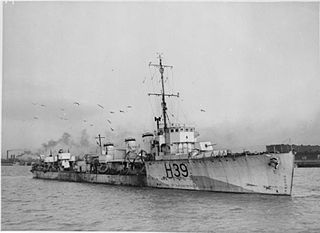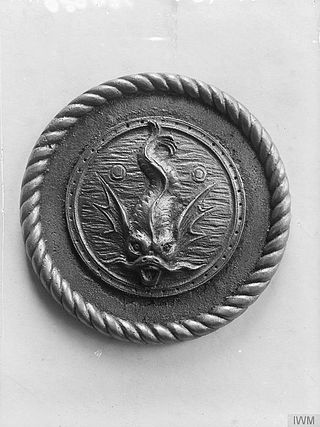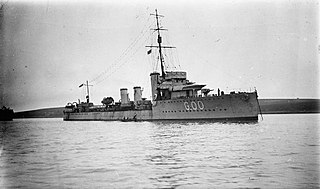
HMS Ithuriel was a Marksman-class flotilla leader of the British Royal Navy. Originally to have been named Gabriel, the name was changed before her launch. The ship was built by Cammell Laird at Birkenhead, being launched on 8 March 1916 and entering service in August that year. Ithuriel served with the Grand Fleet during the First World War, leading both a destroyer flotilla and a submarine flotilla. She survived the war, before being sold for scrap on 8 November 1921.
HMS Ossory was an Admiralty M-class destroyer built for the Royal Navy during the First World War. She took part in the Battle of Jutland in 1916 and was sold for scrap in 1921.

HMS Lance was a Laforey-class destroyer of the Royal Navy. Launched a few months before the outbreak of the First World War and attached to the Harwich Force, Lance took part in several engagements during the war, including the sinking of the Königin Luise and the Battle off Texel. She was responsible for firing the first British shot of the war.

HMS Valentine was a V and W-class destroyer, built in 1917 for the Royal Navy. She fought in both world wars, serving in several capacities. She was heavily damaged by air attack and beached in 1940 near Terneuzen. Her hulk remained there until it was broken up in 1953.

HMS Tarpon was a Royal Navy R-class destroyer constructed and operational in the First World War. She is named after the large fish Tarpon; one species of which is native to the Atlantic, and the other to the Indo-Pacific Oceans. Tarpon was built by the shipbuilders John Brown & Company at their Clydebank shipyard and was launched in March 1917 and entered service in April that year.

HMS Partridge was a Royal Navy Admiralty M-class destroyer constructed and then operational in the First World War, later being sunk by enemy action in 1917. The destroyer was the sixth Royal Navy vessel to carry the name HMS Partridge.

HMS Rosalind was an R-class destroyer which served with the Royal Navy. The ship was launched by Thornycroft on 14 October 1916 as the first of five similar ships ordered from the yard. The design was used as the basis for five subsequent ships of the S-class also built by the company. Rosalind served as part of the Grand Fleet during the First World War, operating as an escort to other warships and in anti-submarine patrols alongside other destroyers. The vessel was sold to be broken up on 13 July 1926.

HMS Rob Roy was a Royal Navy R-class destroyer constructed and then operational in the First World War. The ship served in the Grand Fleet as part of the Fifteenth Destroyer Flotilla.

HMS Kempenfelt was a Marksman-class flotilla leader of the British Royal Navy. She was built by the Cammell Laird at their Birkenhead shipyard, with construction starting in 1914 and completed in August 1915. She served through the remainder of the First World War. She was sold for scrap in 1921.

HMS Telemachus was a R-class destroyer of the British Royal Navy that took part in the First World War. She was built in 1916–1917 by the Scottish shipbuilder John Brown at their Clydebank shipyard. Telemachus was modified to serve as a minelayer, laying minefields in the German Bight and English Channel to restrict the operation of German submarines. The ship survived the war and was sold for scrap in 1927.

HMS Tirade was a Modified Admiralty R-class destroyer which served with the Royal Navy during World War I. The Modified R class added attributes of the Yarrow Later M class to improve the capability of the ships to operate in bad weather. Launched in April 1917 by Scotts Shipbuilding and Engineering Company, the vessel served with the Grand Fleet. The vessel was involved in escorting convoys in the Irish Sea and North Sea. During one of these duties, in September 1917, Tirade sank the minelaying submarine UC-55. During the following month, the destroyer accidentally struck and sank the M-class destroyer Marmion. After the war the destroyer was placed in reserve and then, in November 1921, was sold to be broken up.

HMS Sorceress was an R-class destroyer which served with the Royal Navy during World War I. Launched on 29 August 1916, the vessel operated as part of the Grand Fleet until it was disbanded in 1919. In 1917, the ship took part in action against the German Sixth Destroyer Flotilla and was one of those credited with bounty for the German auxiliary cruiser Konprinz Willhelm. The destroyer was sold to be broken up on 29 April 1927.

HMS Seymour was a Parker-class flotilla leader of the British Royal Navy. She was built by Cammell Laird during the First World War, being launched on 31 August 1916 and completing on 30 November that year. Seymour served with the Grand Fleet for the rest of the war, which she survived. The ship was sold for scrap in January 1931.

HMS Magic was an Admiralty M-class destroyer which served with the Royal Navy during the First World War. The M class were an improvement on the previous L class, capable of higher speed. Originally laid down as HMS Marigold by J. Samuel White at East Cowes on the Isle of Wight, the vessel was renamed before being launched in 1915. The ship served during the War as part of the Grand Fleet, mainly on anti-submarine and convoy escort duties from the port of Queenstown. In 1917, the destroyer took part in the Battle of Jutland and was one of a small number of British vessels that attacked the German fleet with torpedoes, although both torpedoes missed. In 1918, the ship struck a mine of the coast of Ireland and, although the damage was repaired, 25 people died. After the War, the destroyer was placed in reserve and decommissioned, being sold to be broken up in 1921.

HMS Plover was a Admiralty M-class destroyer which served with the Royal Navy during the First World War. The M class were an improvement on the previous L-class, capable of higher speed. Launched on 3 March 1916 by Hawthorn Leslie on the River Tyne, the vessel served as part of the Grand Fleet. Plover was based at Scapa Flow and took part in sorties in response to German submarine activity. After an uneventful war, the destroyer was placed in reserve and decommissioned, being sold to be broken up on 9 May 1921.

HMS Pellew was a Admiralty M-class destroyer which served with the Royal Navy during the First World War. The M class were an improvement on the preceding L class, capable of higher speed. Launched on 18 April 1916, the vessel served with the Grand Fleet escorting convoys. The vessel was part of an unsuccessful attempt by the navy to trap the German submarines that had taken such a heavy toll on merchant shipping in December 1917. The action involved an eight-ship convoy consisting of four merchant vessels escorted by two armed trawlers and the sister ships Pellew and Partridge. Instead of submarines, four German destroyers attacked, sinking all but one member of the convoy and disappearing before the light cruisers which were to be the spring in the trap could arrive. Pellew, the sole survivor, took refuge in a Norwegian fjord. After the armistice that ended the war, the destroyer was placed in reserve and subsequently sold to be broken up on 9 May 1921.

HMS Napier was a Repeat Admiralty M-class destroyer which served in the Royal Navy during the First World War. The M class were an improvement on the previous L-class destroyer, capable of higher speed. The vessel was launched on 27 November 1915 and joined the Grand Fleet. Napier had a varied war career, acting as part of the destroyer screen for the First Battle Squadron during the Second Battle of Heligoland Bight and searching for the survivors of losses like the armoured cruiser HMS Hampshire. The vessel was usually based at Scapa Flow but spent a brief time seconded to the Harwich Force in 1917. After the Armistice that marked the end of the First World War, Napier was placed in reserve before being decommissioned and sold to be broken up on 8 November 1921.

HMS Orestes was a Repeat Admiralty M-class destroyer which served in the Royal Navy during the First World War. The M class were an improvement on the previous L-class destroyer, capable of higher speed. The vessel was launched on 21 March 1916 and joined the Grand Fleet. Orestes was involved in seeking submarines in the North Sea, patrolling both independently and as part of large operations. The destroyer did not report any submarines destroyed, but did rescue the survivors from Q-ship Privet after that vessel had successfully sunk the submarine U-85 in a duel in March 1917. Later in the war, the focus was turned to escorting merchant ships and the destroyer helped secure convoys that crossed the Atlantic Ocean. After the Armistice that marked the end of the First World War, the destroyer was placed into reserve until being, on 30 January 1921, decommissioned and sold to be broken up.

HMS Octavia was an Admiralty M-class destroyer which served in the Royal Navy during the First World War. The M class were an improvement on the previous L-class, capable of higher speed. The vessel was launched on 21 June 1916 and joined the Grand Fleet. Octavia joined the Thirteenth Destroyer Flotilla, which, in 1917, participated in a large anti-submarine warfare operation in the North Sea. The sortie led to three German submarines being sunk, although Octavia was not directly involved in these attacks. In 1918, the flotilla was involved in one of the final sorties of the Grand Fleet, but again the destroyer saw no action at the time. After the Armistice that marked the end of the First World War, Octavia was placed in reserve, decommissioned and, on 5 November 1921, sold to be broken up.

HMS Mindful was a Admiralty M-class destroyer which served with the Royal Navy during the First World War. The M class destroyers were an improvement on the previous L-class, capable of higher speed. The vessel, launched in 1915, joined the Twelfth Destroyer Flotilla under the flotilla leader Faulknor. The ship saw action during the Battle of Jutland in May 1916 and helped sink the German torpedo boat SMS V48. In March 1917, the destroyer was involved in a friendly fire incident, nearly sinking the British submarine G12. In June that year, the vessel was involved in the sinking of the German merchant ship SS Gamma in Norwegian waters, which led to a diplomatic protest from the Norwegian government. At the end of the war, Mindful was withdrawn from service and, in 1921, sold to be broken up.















